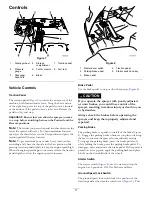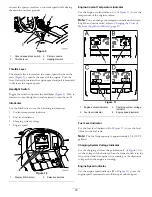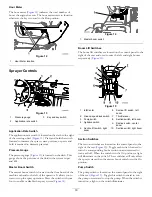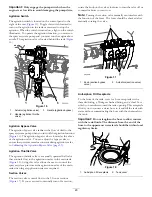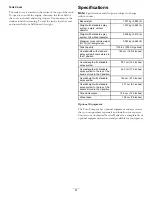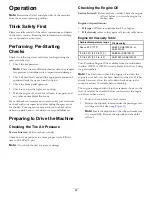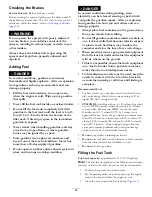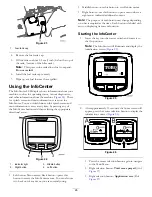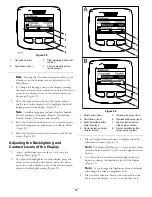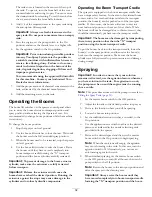
Checking the Brakes
Service Interval:
Before each use or daily
Before starting the sprayer, lightly press the brake pedal. If
the pedal travels more than 2.5 cm (1 inch) before you feel
resistance, adjust the brakes; refer to
(page 54)
.
WARNING
If you operate the sprayer with poorly adjusted
or worn brakes, you could lose control of the
sprayer, resulting in serious injury or death to you
or bystanders.
Always check the brakes before operating the
sprayer and keep them properly adjusted and
repaired.
Adding Fuel
DANGER
In certain conditions, gasoline is extremely
flammable and highly explosive. A fire or explosion
from gasoline can burn you and others and can
damage property.
•
Fill the fuel tank outdoors, in an open area,
when the engine is cold. Wipe up any gasoline
that spills.
•
Never fill the fuel tank inside an enclosed trailer.
•
Do not fill the fuel tank completely full. Add
gasoline to the fuel tank until the level is 6 to 13
mm (1/4 to 1/2 inch) below the bottom of the
filler neck. This empty space in the tank allows
gasoline to expand.
•
Never smoke when handling gasoline, and stay
away from an open flame or where gasoline
fumes may be ignited by a spark.
•
Store gasoline in an approved container and
keep it out of the reach of children. Never buy
more than a 30-day supply of gasoline.
•
Do not operate without entire exhaust system in
place and in proper working condition.
DANGER
In certain conditions during fueling, static
electricity can be released causing a spark which
can ignite the gasoline vapors. A fire or explosion
from gasoline can burn you and others and can
damage property.
•
Always place fuel containers on the ground away
from your vehicle before filling.
•
Do not fill gasoline containers inside a vehicle or
on a truck or trailer bed because interior carpets
or plastic truck bed liners may insulate the
container and slow the loss of any static charge.
•
When practical, remove gas-powered equipment
from the truck or trailer and refuel the equipment
with its wheels on the ground.
•
If this is not possible, then refuel such equipment
on a truck or trailer from a portable container,
rather than from a fuel dispenser nozzle.
•
If a fuel dispenser nozzle must be used, keep the
nozzle in contact with the rim of the fuel tank
or container opening at all times until fueling is
complete.
Recommended Fuel
•
For best results, use only clean, fresh (less than 30 days
old), unleaded gasoline with an octane rating of 87 or
higher ((R+M)/2 rating method).
•
ETHANOL
: Gasoline with up to 10% ethanol (gasohol)
or 15% MTBE (methyl tertiary butyl ether) by volume
is acceptable. Ethanol and MTBE are not the same.
Gasoline with 15% ethanol (E15) by volume is not
approved for use. Never use gasoline that contains more
than 10% ethanol by volume, such as E15 (contains 15%
ethanol), E20 (contains 20% ethanol), or E85 (contains
up to 85% ethanol ). Using unapproved gasoline may
cause performance problems and/or engine damage
which may not be covered under warranty
•
Do not
use gasoline containing methanol.
•
Do not
store fuel either in the fuel tank or fuel containers
over the winter unless a fuel stabilizer is used.
•
Do not
add oil to gasoline.
Filling the Fuel Tank
Fuel tank capacity:
approximately 45 L (12 US gallons).
Note:
The fuel level is displayed in the InfoCenter and shows
the level of fuel in the tank—check the fuel level frequently.
1.
Position the sprayer on a level surface.
2.
Set the parking brake, stop the pump, stop the engine,
remove the key, and allow the engine to cool.
3.
Clean the area around the fuel-tank cap (
).
25







